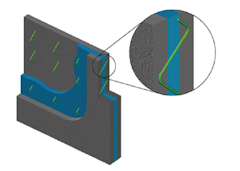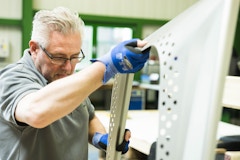124 results
-
The pathway to carbon-neutrality, as urged during the COP 21 in Paris, and the repeated goal for resilient buildings and urban habitats, winds right…
-

A Break From The Past: How the Guggenheim Renovation Made Thermally Broken Steel Windows a New Normal
- Article by Angel Ayón, AIA, NCARB, NOMA, LEED AP, Principal
-

Design Considerations and the Complex Facade
- Paper by Stan Su,
The design of complex, high-performance facades involves balancing attention towards principles of material selection, thermal and moisture… -

Effect of Thermal Bridging on Buildings' Energy Performance
- Paper by Mahsa Farid Mohajer · Ajla Aksamija
Heat transfer through building facades can occur by any combinations of conduction, convection, and/or radiation. Conductive heat transfer depends on
-

Terra Cotta Skins
- Paper by Laura B. Garofalo, Assistant Professor
This paper will address the potential of ornamental architectural terracotta surfaces to mitigate the effects of climate fluctuations that will… -

Iconic Buildings
- Paper by Xavier Ferrés Padró · Paula Martín Goñi
The iconic building principal incentive is to be visually attractive or stand out, for this purpose three main features must be accomplished: have a
-
Determination of Surface Flaw Parameters for Annealed and Fully Tempered Glass Exposed to NaCl
- Paper by Nabhajit Goswami, PhD, Senior Facade Engineer Joshua Schultz, PhD, PE, LEED AP, Associate Professor Patrick Ferro, PhD, PE, MBA, Professor Stephen M Morse, PhD, PE, Associate Teaching Professor, Mechanical Engineering-Engineering Mechanics Affiliated Assistant Professor, Civil, Environmental, and Geospatial Engineering
The use of glass in the exterior facades provides greater light transmission into the building and improved views for occupants. Coastal areas in… -
Facade Design Beyond Buildings
- Paper by Michele Andaloro, Associate Enrica Oliva, Partner and COO Lucio Blandini, Managing Director
At the core of facade design is the concept of interdisciplinarity, a bridge between concept and materialization apt to relay a built form… -

More Than a Facade
- Paper by Edward Losch · Marc Maguire
In 2014, the American National Standards Institute (ANSI) approved the Precast/Prestressed Concrete Institute (PCI) as an accredited ANSI Standards
-
Hydroformed Shading
- Paper by Michelle Siu-Ching Lee · Robert Matthew Noblett · Roman Schieber
New approaches to lightweight metal forming have the potential to advance architectural fabrication, particularly in the design and engineering of
-

Renewing Historic Facades
- Paper by Christine Reynolds, PE · Hans Thummel, AIA, LEED AP BD+C
As the first phase of a $4 billion dollar, 180-acre, 60 building government preservation project in Washington DC, this case study reviews the
-

Environmental Facade Perspective
- Paper by Patricia Shaw, M Arch., MSc Facade Engineering
Designing a sustainable rainscreen wall assembly has become an essential part of most new construction projects. Industry principles and energy codes
-
A Compact, Unitized Double Skin Facade
- Paper by Alex Cox, LEED AP · James Hock, LEED AP BD+C · Laura Ziegler · Karin Lamberts
Driven by an increasing demand for high thermal and acoustic performance, transparency, and low maintenance costs, a number of facade innovations
-
Investigating Heat Development in Shadow Box Façade Systems
- Paper by Ahmet Faruk Cakir, Master's Student in Facade Engineering and Werkstudent at Schüco Prof. Daniel Arztmann, Head of Custom Design International and Professor at TH OWL
The prevalence of fully glazed facades in modern office buildings has been steadily increasing, primarily driven by architects' focus on aesthetic… -

ETFE Membrane Envelope Strategies
- Paper by Audrey L Worden, ISSF · Kihong R. Ku, DDes · Alexander G. Worden, RA NCARB
Airflow within the cavity of double-skin facades is a key component of adaptive building envelopes which change thermophysical properties to meet
-

End-of-Life Challenges in Facade Design
- Paper by Rebecca Hartwell · Mauro Overend
In recent decades, there has been increased attention to reduce the operational energy performance of buildings. Stringent legislation on building
-

Passively Actuated Systems
- Paper by Manuel Benitez Ruiz, Student David Gerber, Associate Professor of Practice
Kinetic or responsive facades have been developed to improve buildings' daylighting conditions while mitigating energy consumption. Still, these…

